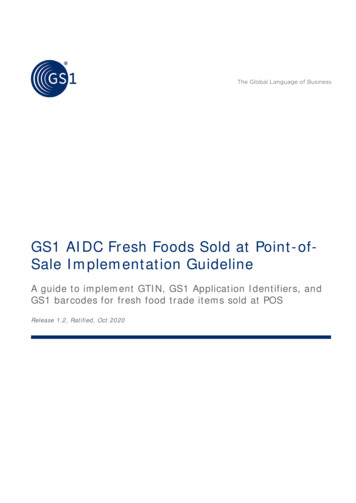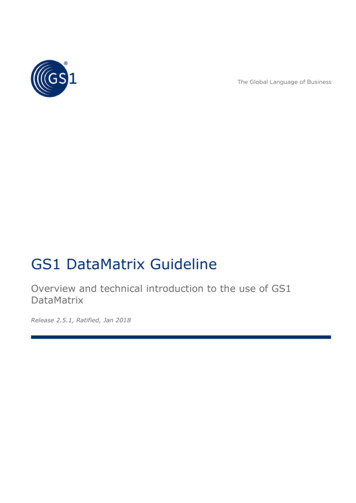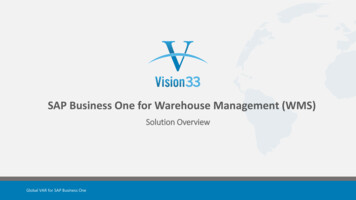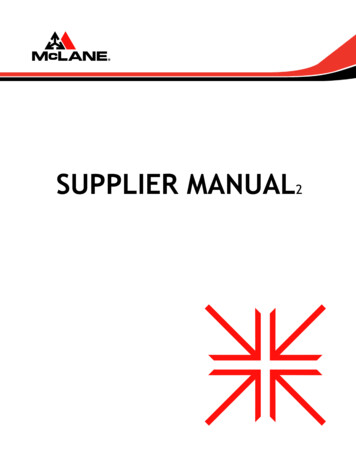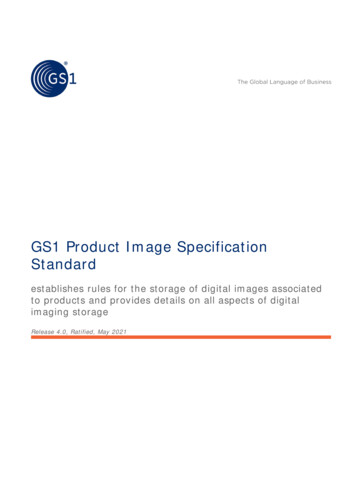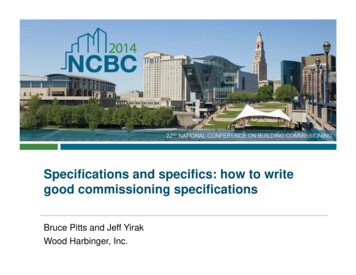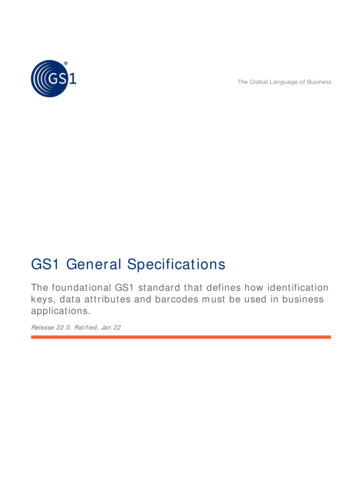
Transcription
GS1 General SpecificationsThe foundational GS1 standard that defines how identificationkeys, data attributes and barcodes must be used in businessapplications.Release 22.0, Ratified, Jan 22
GS1 General SpecificationsDocument SummaryDocument itemCurrent valueDocument nameGS1 General SpecificationsDocument typeStandardDocument dateJan 22Document version22.0Document issueDocument statusRatifiedDocument descriptionThe foundational GS1 standard that defines how identification keys,data attributes and barcodes must be used in business applications.Document web addresshttps://www.gs1.org/genspecsChange Log in this releaseImpact on sectionGens Specs Change Notification(GSCN)Summary of change1GSCN for 21-271Definition/use of GS1 LN modernisationClarify GTIN-14 creationDefinition/use of GS1 prefixHC minimum AIDC markingDynamic assortmentPredefined/random assortmentNHRN for NDCGTIN-8/EAN-clarificationASP for POSErrata3GSCN for 21-040GSCN for 21-118GSCN for 21-289Expiry data for HCGRAI clarificationNHRN for NDCErrata4GSCN for 20-180GSCN for 21-118GSCN for 21-289GLN modernisationGRAI clarificationNHRN for -28721-24821-27821-28921-32521-34256Errata7GSCN for 21-028GSCN for 21-289GS1 AI lengthsNHRN for NDC8GSCN for 21-342ASP for POSErrata9GSCN for 20-180GSCN for 21-271GSCN for 21-342GLN modernisationDefinition/use of GS1 prefixASP for POSFull log of changes on https://www.gs1.org/standards/genspecs/gscn archiveRelease 22.0, Ratified, Jan 22 2022 GS1 AISBLPage 2 of 528
GS1 General SpecificationsDisclaimerGS1 , under its IP Policy, seeks to avoid uncertainty regarding intellectual property claims by requiring the participants inthe Work Group that developed this GS1 General Specifications Standard to agree to grant to GS1 members a royaltyfree licence or a RAND licence to Necessary Claims, as that term is defined in the GS1 IP Policy. Furthermore, attention isdrawn to the possibility that an implementation of one or more features of this Specification may be the subject of a patentor other intellectual property right that does not involve a Necessary Claim. Any such patent or other intellectual propertyright is not subject to the licencing obligations of GS1. Moreover, the agreement to grant licences provided under the GS1IP Policy does not include IP rights and any claims of third parties who were not participants in the Work Group.Accordingly, GS1 recommends that any organisation developing an implementation designed to be in conformance with thisSpecification should determine whether there are any patents that may encompass a specific implementation that theorganisation is developing in compliance with the Specification and whether a licence under a patent or other intellectualproperty right is needed. Such a determination of a need for licencing should be made in view of the details of the specificsystem designed by the organisation in consultation with their own patent counsel.THIS DOCUMENT IS PROVIDED “AS IS” WITH NO WARRANTIES WHATSOEVER, INCLUDING ANY WARRANTY OFMERCHANTABILITY, NONINFRINEGMENT, FITNESS FOR PARTICULAR PURPOSE, OR ANY WARRANTY OTHER WISE ARISINGOUT OF THIS SPECIFICATION. GS1 disclaims all liability for any damages arising from use or misuse of this Standard,whether special, indirect, consequential, or compensatory damages, and including liability for infringement of anyintellectual property rights, relating to use of information in or reliance upon this document.GS1 retains the right to make changes to this document at any time, without notice. GS1 makes no warranty for the use ofthis document and assumes no responsibility for any errors which may appear in the document, nor does it make acommitment to update the information contained herein.GS1 and the GS1 logo are registered trademarks of GS1 AISBL.Release 22.0, Ratified, Jan 22 2022 GS1 AISBLPage 3 of 528
GS1 General SpecificationsWho should read the General Specifications?Technical experts working with the GS1 system should read these specifications. They provide a globalreference document covering all technical aspects of the GS1 system. Their primary objective is to define theinternational standard upon which individual GS1 Member Organisations can develop user documentation.NavigatorThese specifications have been developed as a reference document aimed primarily at GS1 MemberOrganisations (who also produce local language user manuals) and system engineers developing softwarebased upon GS1 system standards. All aspects of the GS1 system are summarised in section 1, which isrecommended for those wishing to become familiar with the GS1 system logic and terminology.Each application section mandates the use of system features defined elsewhere in this document, such ascheck digits, element strings, data carriers and barcode symbol placement. The sections of these GS1 GeneralSpecifications are: Section 1 Basics and principles of the GS1 system: Provides an introduction to the core componentsof the GS1 system. Section 2 Application standards: Provides a definition for each GS1 application using a templateformat. Each application is uniquely identified and contains a description, the associated GS1 key, itsdefinition and links to relevant data structures and attributes (section 3), rules (section 4), carrierspecifications (section 5), placement (section 6) and unique processing requirements (section 7). Section 3 GS1 Application Identifier definitions: Describes the meaning, structure and function ofthe GS1 element strings so they can be correctly processed in users’ application programs. Section 4 Application rules: Provides the rules for use of GS1 keys in their application environments.Differences in industries are included as well as the data relationship rules for GS1 Application Identifieruse. Section 5 Data carriers: Provides a detailed description of the data carriers that are endorsed by GS1.It includes symbol specification tables for use in the supply chain operational environment as well as therelated barcode production and quality assessment required to achieve excellent scan rates. Section 6 Symbol placement guidelines: Provides guidance on symbol placement as well as transportlabel standards and tag standards. Section 7 AIDC validation rules: Provides rules for validating and processing GS1 element stringswithout human intervention. Check digit and calendar date algorithms are also included. Section 8 Application Standard Profiles Provides a summary of application conformancerequirements, organised in modular way to make it easier to find the relevant sections. Section 9 GS1 Standards glossary of terms: A standard vocabulary used throughout the GS1 system.Release 22.0, Ratified, Jan 22 2022 GS1 AISBLPage 4 of 528
GS1 General SpecificationsTable of Contents1Basics and principles of the GS1 system . 151.11.21.31.41.51.61.72The GS1 General Specifications . 161.1.1Introduction . 161.1.2Who should read these specifications . 161.1.3Foundational standard . 161.1.4Maintenance responsibility and management . 171.1.5Verbal forms used in normative statements . 17GS1 system principles . 18Identification system policies . 191.3.1Mandatory identifiers. 191.3.2Non-GS1 identifiers . 191.3.3GS1 Company Prefix . 191.3.4Carrier independence . 191.3.5GS1 business messages. 19The GS1 identification system . 201.4.1Global, open versus restricted . 201.4.2GS1 Prefix . 201.4.3GS1-8 Prefix . 211.4.4GS1 Company Prefix . 211.4.5U.P.C. Prefix. 211.4.6U.P.C. Company Prefix . 221.4.7GS1 identification key . 221.4.8Character set . 22GS1 Company Prefix allocation . 24Allocation . 251.6.1Acquisitions and mergers . 251.6.2Split or spin-off . 26Sunrise and sunset dates . 27Application standards . 282.12.2Trade items . 292.1.1Introduction . 292.1.2Fixed measure trade items – open supply chain . 332.1.3Fixed measure trade items scanned at retail POS . 342.1.4Fixed measure trade items scanned in general distribution and at retail POS . 422.1.5Healthcare primary packaging (non-retail trade items) . 432.1.6Healthcare secondary packaging (regulated healthcare retail consumer trade items) . 462.1.7Fixed measure trade items scanned in general distribution. 482.1.8Medical devices (non-retail trade items) . 552.1.9Fixed measure trade items packed in several individual pieces not scanned at retail POS 572.1.10Variable measure trade items scanned in general distribution . 592.1.11Fixed measure trade items – restricted distribution applications. 662.1.12Variable measure trade items scanned at retail POS . 712.1.13Trade item extended packaging applications . 752.1.14European Regulation 2018/574, traceability of tobacco products. 78Logistic units . 86Release 22.0, Ratified, Jan 22 2022 GS1 AISBLPage 5 of 528
GS1 General Specifications2.32.42.52.62.732.2.1Individual logistic units . 862.2.2Multiple logistic units – Global Identification Number for Consignment . 872.2.3Multiple logistic units – Global Shipment Identification Number. 88Assets . 902.3.1Global Returnable Asset Identifier (GRAI): AI (8003) . 902.3.2Global Individual Asset Identifier (GIAI): AI (8004). 91Parties and locations . 942.4.1Application overview . 942.4.2Identification of a physical location . 952.4.3Physical locations in business processes. 972.4.4Identification of a party . 982.4.5Parties in business processes . 99Service relationships . 1012.5.1Global Service Relation Number – Provider: AI (8017) .1012.5.2Global Service Relation Number – Recipient: AI (8018) .1022.5.3Service Relation Instance Number: AI (8019) .104Special applications . 1052.6.1Coupons .1052.6.2Coupons identified using the Global Coupon Number .1062.6.3Coupons with restricted geographic distribution .1112.6.4Refund receipts .1152.6.5Electronic serial identifier for cellular mobile telephones (CMTI): AI (8002) .1172.6.6Payment slips .1182.6.7Customer specific articles .1212.6.8Custom trade item .1252.6.9Global Document Type Identifier for document control .1282.6.10Internal applications.1322.6.11Consumer trade item production control .1332.6.12Component/part identification .1352.6.13Global Model Number (GMN) .1382.6.14Permanently marked items .1402.6.15Encoding transport process information .142Summary of applications and operative scanning environments . 145GS1 Application Identifier definitions . 1483.1Introduction . 1493.2GS1 Application Identifiers in numerical order. 1503.3GS1 Application Identifiers starting with digit 0 . 1563.43.3.1Identification of a logistic unit (SSCC): AI (00) .1563.3.2Identification of a trade item (GTIN): AI (01) .1563.3.3Identification of trade items contained in a logistic unit: AI (02) .156GS1 Application Identifiers starting with digit 1 . 1583.4.1Batch or lot number: AI (10) .1583.4.2Production date: AI (11) .1583.4.3Due date for amount on payment slip: AI (12) .1593.4.4Packaging date: AI (13).1593.4.5Best before date: AI (15) .1603.4.6Sell by date: AI (16) .1613.4.7Expiration date: AI (17).161Release 22.0, Ratified, Jan 22 2022 GS1 AISBLPage 6 of 528
GS1 General Specifications3.53.6GS1 Application Identifiers starting with digit 2 . 1633.5.1Internal product variant: AI (20) .1633.5.2Serial number: AI (21) .1633.5.3Consumer product variant: AI (22) .1633.5.4(235)Third Party Controlled, Serialised Extension of Global Trade Item Number (GTIN) (TPX): AI1643.5.5Additional product identification assigned by the manufacturer: AI (240) .1653.5.6Customer part number: AI (241) .1653.5.7Made-to-Order variation number: AI (242) .1653.5.8Packaging component number: AI (243) .1663.5.9Secondary serial number: AI (250) .1663.5.10Reference to source entity: AI (251) .1673.5.11Global Document Type Identifier (GDTI): AI (253) .1673.5.12Global Location Number (GLN) extension component: AI (254) .1683.5.13Global Coupon Number (GCN): AI (255) .168GS1 Application Identifiers starting with digit 3 . 1693.6.1Variable count of items: AI (30) .1693.6.2Trade measures: AIs (31nn, 32nn, 35nn, 36nn) .1693.6.3Logistic measures: AIs (33nn, 34nn, 35nn, 36nn) .1703.6.4Kilograms per square metre: AI (337n) .1713.6.5Count of trade items or trade item pieces contained in a logistic unit: AI (37) .1723.6.6Amount payable or coupon value - Single monetary area: AI (390n) .1723.6.7Amount payable and ISO currency code: AI (391n).1733.6.8Amount payable for a variable measure trade item – Single monetary area: AI (392n).1733.6.9Amount payable for a variable measure trade item and ISO currency code: AI (393n).1743.6.10Percentage discount of a coupon: AI (394n) .1753.6.11 Amount payable per unit of measure single monetary area (variable measure trade item):AI (395n) .1753.7GS1 Application Identifiers starting with digit 4 . 1773.7.1Customer’s purchase order number: AI (400).1773.7.2Global Identification Number for Consignment (GINC): AI (401) .1773.7.3Global Shipment Identification Number (GSIN): AI (402) .1783.7.4Routing code: AI (403) .1783.7.5Ship to - Deliver to Global Location Number (GLN): AI (410).1793.7.6Bill to - Invoice to Global Location Number (GLN): AI (411) .1793.7.7Purchased from Global Location Number (GLN): AI (412) .1793.7.8Ship for - Deliver for - Forward to Global Location Number (GLN): AI (413) .1803.7.9Identification of a physical location - Global Location Number (GLN): AI (414) .1803.7.10Global Location Number (GLN) of the invoicing party: AI (415).1813.7.11Global Location Number (GLN) of the production or service location: AI (416) .1813.7.12Party Global Location Number (GLN): AI (417) .1823.7.13Ship-to / Deliver-to postal code within a single postal authority: AI (420) .1823.7.14Ship-to / Deliver-to postal code with three-digit ISO country code: AI (421) .1823.7.15Country of origin of a trade item: AI (422).1833.7.16Country of initial processing: AI (423) .1833.7.17Country of processing: AI (424) .1843.7.18Country of disassembly: AI (425) .1843.7.19Country covering full process chain: AI (426) .1843.7.20Country subdivision of origin code for a trade item: AI (427).185Release 22.0, Ratified, Jan 22 2022 GS1 AISBLPage 7 of 528
GS1 General Specifications3.83.7.21Ship-to / Deliver-to Company name: AI (4300) .1853.7.22Ship-to / Deliver-to contact name: AI (4301) .1863.7.23Ship-to / Deliver-to address line 1: AI (4302).1863.7.24Ship-to / Deliver-to address line 2: AI (4303).1863.7.25Ship-to / Deliver-to suburb: AI (4304) .1873.7.26Ship-to / Deliver-to locality: AI (4305) .1873.7.27Ship-to / Deliver-to region: AI (4306) .1873.7.28Ship-to / Deliver-to country code: AI (4307) .1883.7.29Ship-to / Deliver-to telephone number: AI (4308) .1883.7.30Return-to company name: AI (4310) .1883.7.31Return-to contact name: AI (4311) .1893.7.32Return-to address line 1: AI (4312) .1893.7.33Return-to address line 2: AI (4313) .1893.7.34Return-to suburb: AI (4314) .1903.7.35Return-to locality: AI (4315) .1903.7.36Return-to region: AI (4316) .1903.7.37Return-to country code: AI (4317) .1903.7.38Return-to postal code: AI (4318) .1913.7.39Return-to telephone number: AI (4319) .1913.7.40Service code description: AI (4320) .1913.7.41Dangerous goods flag: AI (4321) .1923.7.42Authority to leave flag: AI (4322) .1923.7.43Signature required flag: AI (4323) .1923.7.44Not before delivery date/time: AI (4324) .1933.7.45Not after delivery date/time: AI (4325) .1933.7.46Release date: AI (4326) .194GS1 Application Identifiers starting with digit 7 . 1953.8.1Seven series AIs - Cautionary note .1953.8.2NATO Stock Number (NSN): AI (7001) .1953.8.3UN/ECE meat carcasses and cuts classification: AI (7002) .1953.8.4Expiration date and time: AI (7003) .1963.8.5Active potency: AI (7004) .1963.8.6Catch area: AI (7005) .1973.8.7First freeze date: AI (7006) .1973.8.8Harvest date: AI (7007) .1983.8.9Species for fishery purposes: AI (7008) .1983.8.10Fishing gear type: AI (7009) .1993.8.11Production method: AI (7010) .1993.8.12Refurbishment lot ID: AI (7020) .2003.8.13Functional status: AI (7021) .2003.8.14Revision status: AI (7022) .2013.8.15Global Individual Asset Identifier of an assembly: AI (7023) .2013.8.16Number of processor with three-digit ISO country code: AI (703s).2013.8.17GS1 UIC with Extension 1 and Importer index: AI (7040) .2023.8.18 National Healthcare Reimbursement Number (NHRN): AIs (710), (711), (712), (713),(714) and (715) .2033.93.8.19Certification reference: AI (723s).2043.8.20Protocol ID: AI (7240) .205GS1 Application Identifiers starting with digit 8 . 206Release 22.0, Ratified, Jan 22 2022 GS1 AISBLPage 8 of 528
GS1 General Specifications3.9.1Roll products - width, length, core diameter, direction, splices: AI (8001) .2063.9.2Cellular mobile telephone identifier: AI (8002) .2063.9.3Global Returnable Asset Identifier (GRAI): AI (8003) .2063.9.4Global Individual Asset Identifier (GIAI): AI (8004).2073.9.5Price per unit of measure: AI (8005) .2073.9.6Identification of an individual trade item (ITIP) piece: AI (8006).2083.9.7International Bank Account Number (IBAN): AI (8007).2083.9.8Date and time of production: AI (8008) .2093.9.9Optically readable sensor indicator: AI (8009) .2093.9.10Component/Part Identifier (CPID): AI (8010) .2103.9.11Component/Part Identifier serial number: AI (8011) .
These specifications have been developed as a reference document aimed primarily at GS1 Member Organisations (who also produce local language user manuals) and system engineers developing software
